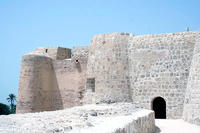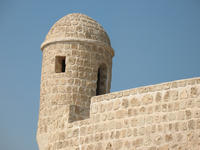You are in: Middle East -> Bahrain -> Qal’at al-Bahrain ... , and traditional search or Image Gallery will yield results of this site only
Qal’at al-Bahrain – Ancient Harbour and Capital of Dilmun
| Site number: | 1192 |
|
| Type of site: | Cultural | |
| Date: | 2300 BC-16th ce | |
| Date of Inscription: | 2005 | |
| Location: | Middle East, Bahrain, Northern Region | |
Up to 75 images are shown here. Click on each for more details or on Image Gallery for more images.
| Description: | Qal'at al–Bahrain is an artificial earthen mound (a "tell") created through layers of successive human occupation. The continuous human presence from about 2300 B.C. to the 16th century A.D can be traced through the 300x600-metre tell (hill). Excavations of 25% of the site have revealed different types of underlying structures (residential, public, commercial, religious and military) that testify to the importance of the site; over the centuries the place acted as a trading port. An impressive Portuguese fort stands on top of the 12m mound, giving the site its name, qal'a (meaning fort). The site having been the capital of the Dilmun (one of the main ancient civilizations of the area) contains the richest documented remains of this civilization, which had previously only been found referenced in Sumerian texts. --WHMNet paraphrase from the description at WHC Site, where additional information is available. | |
| Qal`at al-Bahrain (Arabic: قلعة البحرين) is an archaeological site located in Bahrain. It is composed of an artificial mound created by human inhabitants from 2300 BC up to the 1700's. Among other things, it was once the capital of the Dilmun civilization, and served more recently as a Portuguese fort. For these reasons, it was inscribed as a UNESCO World Heritage Site in 2005. Qal`at al-Bahrain is a typical tell – an artificial mound created by many successive layers of human occupation. The strata of the 300x600-metre tell testify to continuous human presence from about 2300 B.C. to the 16th century A.D. About 25% of the site has been excavated revealing structures of different types: residential, public, commercial, religious and military. They testify to the importance of the site as a trading port over the centuries. On the top of the 12m high mound, there is the impressive Portuguese fort, which gave the whole site its name, qal`a, meaning fort. The site was the capital of the Dilmun, one of the most important ancient civilizations of the region. It contains the richest remains inventoried of this civilization, which was hitherto only known from written Sumerian references. --Wikipedia. Text is available under the Creative Commons Attribution-ShareAlike License. | ||
| Source: | http://whc.unesco.org/en/list/1192 | |
| Reference: | 1. UNESCO World Heritage Center, Site Page. | |







































